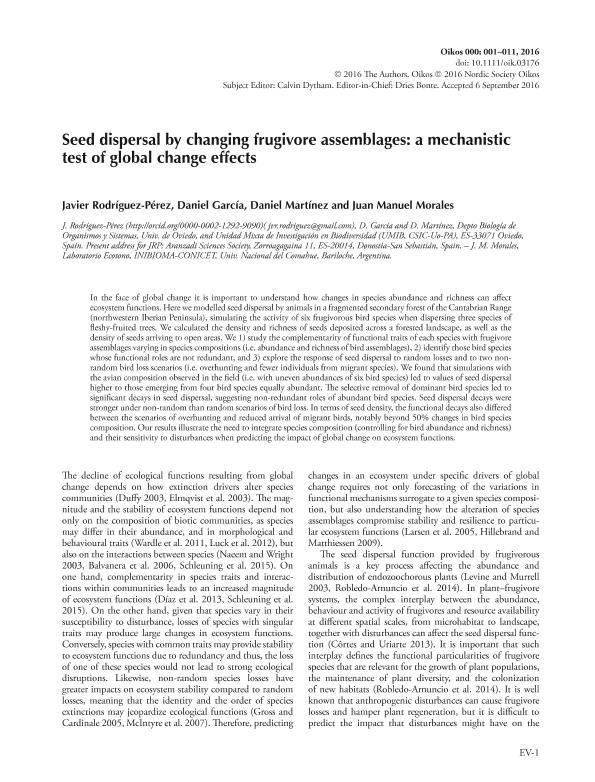Mostrar el registro sencillo del ítem
dc.contributor.author
Perez Rodriguez, Jose

dc.contributor.author
García, Daniel
dc.contributor.author
Martínez, Daniel
dc.contributor.author
Morales, Juan Manuel

dc.date.available
2018-01-05T19:51:53Z
dc.date.issued
2016-11
dc.identifier.citation
García, Daniel; Martínez, Daniel; Morales, Juan Manuel; Perez Rodriguez, Jose; Seed dispersal by changing frugivore assemblages: a mechanistic test of global change effects; Wiley; Oikos; 126; 5; 11-2016; 671-681
dc.identifier.issn
0030-1299
dc.identifier.uri
http://hdl.handle.net/11336/32444
dc.description.abstract
In the face of global change it is important to understand how changes in species abundance and richness can affect ecosystem functions. Here we modelled seed dispersal by animals in a fragmented secondary forest of the Cantabrian Range (northwestern Iberian Peninsula), simulating the activity of six frugivorous bird species when dispersing three species of fleshy-fruited trees. We calculated the density and richness of seeds deposited across a forested landscape, as well as the density of seeds arriving to open areas. We 1) study the complementarity of functional traits of each species with frugivore assemblages varying in species compositions (i.e. abundance and richness of bird assemblages), 2) identify those bird species whose functional roles are not redundant, and 3) explore the response of seed dispersal to random losses and to two non-random bird loss scenarios (i.e. overhunting and fewer individuals from migrant species). We found that simulations with the avian composition observed in the field (i.e. with uneven abundances of six bird species) led to values of seed dispersal higher to those emerging from four bird species equally abundant. The selective removal of dominant bird species led to significant decays in seed dispersal, suggesting non-redundant roles of abundant bird species. Seed dispersal decays were stronger under non-random than random scenarios of bird loss. In terms of seed density, the functional decays also differed between the scenarios of overhunting and reduced arrival of migrant birds, notably beyond 50% changes in bird species composition. Our results illustrate the need to integrate species composition (controlling for bird abundance and richness) and their sensitivity to disturbances when predicting the impact of global change on ecosystem functions.
dc.format
application/pdf
dc.language.iso
eng
dc.publisher
Wiley

dc.rights
info:eu-repo/semantics/openAccess
dc.rights.uri
https://creativecommons.org/licenses/by-nc-sa/2.5/ar/
dc.subject
Dispersal
dc.subject
Community
dc.subject
Movement
dc.subject.classification
Otras Ciencias Biológicas

dc.subject.classification
Ciencias Biológicas

dc.subject.classification
CIENCIAS NATURALES Y EXACTAS

dc.title
Seed dispersal by changing frugivore assemblages: a mechanistic test of global change effects
dc.type
info:eu-repo/semantics/article
dc.type
info:ar-repo/semantics/artículo
dc.type
info:eu-repo/semantics/publishedVersion
dc.date.updated
2017-12-15T14:31:30Z
dc.journal.volume
126
dc.journal.number
5
dc.journal.pagination
671-681
dc.journal.pais
Estados Unidos

dc.journal.ciudad
Hoboken
dc.description.fil
Fil: Perez Rodriguez, Jose. Universidad de Oviedo; España
dc.description.fil
Fil: García, Daniel. Universidad de Oviedo; España
dc.description.fil
Fil: Martínez, Daniel. Universidad de Oviedo; España
dc.description.fil
Fil: Morales, Juan Manuel. Consejo Nacional de Investigaciones Científicas y Técnicas. Centro Científico Tecnológico Conicet - Patagonia Norte. Instituto de Investigaciones en Biodiversidad y Medioambiente. Universidad Nacional del Comahue. Centro Regional Universidad Bariloche. Instituto de Investigaciones en Biodiversidad y Medioambiente; Argentina
dc.journal.title
Oikos

dc.relation.alternativeid
info:eu-repo/semantics/altIdentifier/doi/http://dx.doi.org/10.1111/oik.03176
dc.relation.alternativeid
info:eu-repo/semantics/altIdentifier/url/http://onlinelibrary.wiley.com/doi/10.1111/oik.03176/abstract
Archivos asociados
